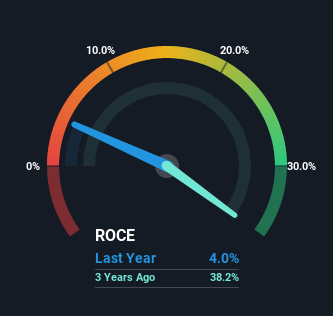- United States
- /
- Energy Services
- /
- NasdaqGS:BOOM
DMC Global (NASDAQ:BOOM) Will Want To Turn Around Its Return Trends
Finding a business that has the potential to grow substantially is not easy, but it is possible if we look at a few key financial metrics. Ideally, a business will show two trends; firstly a growing return on capital employed (ROCE) and secondly, an increasing amount of capital employed. If you see this, it typically means it's a company with a great business model and plenty of profitable reinvestment opportunities. However, after briefly looking over the numbers, we don't think DMC Global (NASDAQ:BOOM) has the makings of a multi-bagger going forward, but let's have a look at why that may be.
Return On Capital Employed (ROCE): What Is It?
For those that aren't sure what ROCE is, it measures the amount of pre-tax profits a company can generate from the capital employed in its business. To calculate this metric for DMC Global, this is the formula:
Return on Capital Employed = Earnings Before Interest and Tax (EBIT) ÷ (Total Assets - Current Liabilities)
0.04 = US$30m ÷ (US$879m - US$128m) (Based on the trailing twelve months to December 2022).
Thus, DMC Global has an ROCE of 4.0%. Ultimately, that's a low return and it under-performs the Energy Services industry average of 9.0%.
Check out our latest analysis for DMC Global

In the above chart we have measured DMC Global's prior ROCE against its prior performance, but the future is arguably more important. If you'd like, you can check out the forecasts from the analysts covering DMC Global here for free.
SWOT Analysis for DMC Global
- Debt is not viewed as a risk.
- Expensive based on P/E ratio and estimated fair value.
- Annual earnings are forecast to grow faster than the American market.
- Revenue is forecast to grow slower than 20% per year.
The Trend Of ROCE
When we looked at the ROCE trend at DMC Global, we didn't gain much confidence. Over the last five years, returns on capital have decreased to 4.0% from 7.5% five years ago. Although, given both revenue and the amount of assets employed in the business have increased, it could suggest the company is investing in growth, and the extra capital has led to a short-term reduction in ROCE. If these investments prove successful, this can bode very well for long term stock performance.
On a side note, DMC Global has done well to pay down its current liabilities to 15% of total assets. So we could link some of this to the decrease in ROCE. Effectively this means their suppliers or short-term creditors are funding less of the business, which reduces some elements of risk. Since the business is basically funding more of its operations with it's own money, you could argue this has made the business less efficient at generating ROCE.
Our Take On DMC Global's ROCE
Even though returns on capital have fallen in the short term, we find it promising that revenue and capital employed have both increased for DMC Global. And there could be an opportunity here if other metrics look good too, because the stock has declined 30% in the last five years. So we think it'd be worthwhile to look further into this stock given the trends look encouraging.
If you're still interested in DMC Global it's worth checking out our FREE intrinsic value approximation to see if it's trading at an attractive price in other respects.
For those who like to invest in solid companies, check out this free list of companies with solid balance sheets and high returns on equity.
New: Manage All Your Stock Portfolios in One Place
We've created the ultimate portfolio companion for stock investors, and it's free.
• Connect an unlimited number of Portfolios and see your total in one currency
• Be alerted to new Warning Signs or Risks via email or mobile
• Track the Fair Value of your stocks
Have feedback on this article? Concerned about the content? Get in touch with us directly. Alternatively, email editorial-team (at) simplywallst.com.
This article by Simply Wall St is general in nature. We provide commentary based on historical data and analyst forecasts only using an unbiased methodology and our articles are not intended to be financial advice. It does not constitute a recommendation to buy or sell any stock, and does not take account of your objectives, or your financial situation. We aim to bring you long-term focused analysis driven by fundamental data. Note that our analysis may not factor in the latest price-sensitive company announcements or qualitative material. Simply Wall St has no position in any stocks mentioned.
About NasdaqGS:BOOM
DMC Global
Provides various products and engineered solutions for the construction, energy, industrial processing, and transportation markets worldwide.
Excellent balance sheet and fair value.
Similar Companies
Market Insights
Community Narratives



